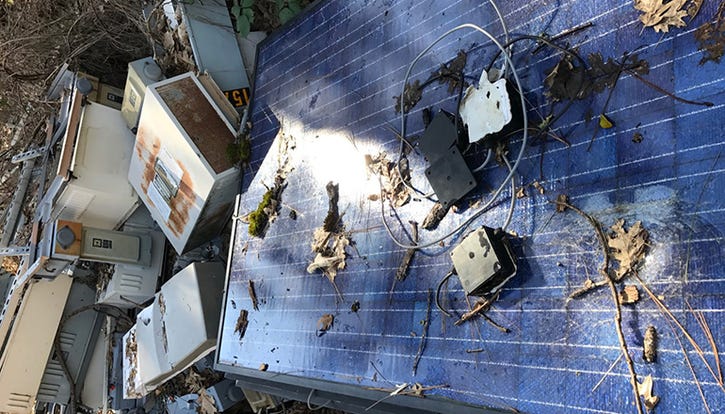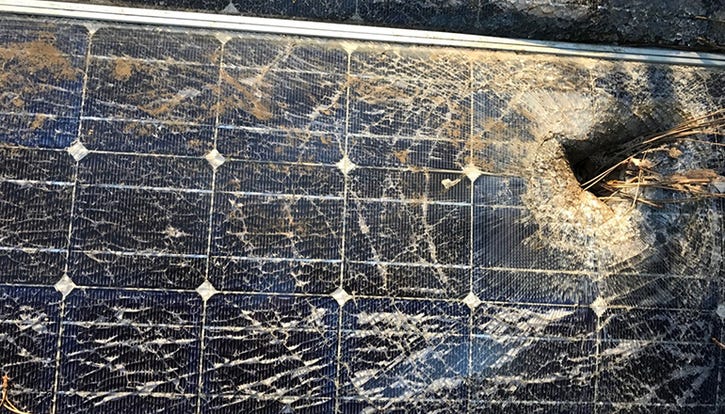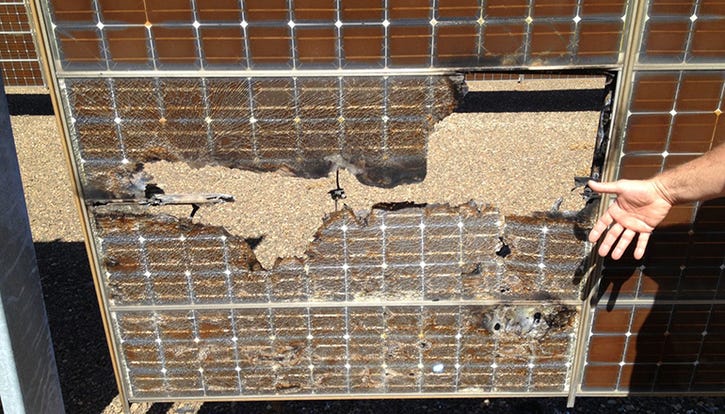What’s Happening with the Growing Volume of Wasted Solar Panels?
Solar panel production in the U.S. is growing, but ensuring panels are recycled at the end of their lifecycle has been a tall task.

Solar panel production in the U.S. is burgeoning. Total installed capacity is expected to more than double over the next five years, and by 2023 annual installations will exceed 15 gigawatts of capacity, representing a continued upward climb, reports the Solar Energy Industry Association.
As new modules go up, volumes of older ones are rapidly reaching the end of their roughly 25-year life; a growing number are not even lasting that long, due to hailstorms and other weather- and fire-related events, says Sam Vanderhoof, CEO of Recycle PV Solar (RPVS). His company is one of a few in business to see that these panels are recycled. But it has been a tall task.
“Now, there are thousands coming down all over the U.S. And solar panel prices have dropped, with used ones valued at only slightly more than one-third of their worth 10 years ago,” he says.
Meanwhile, there is no established infrastructure to collect and transport them, and finding a way to do it has been expensive.

RPVS is trying to streamline the recycling process to make it easier and less expensive.
Incorporated in November 2018, and having found its first investor, the company has serviced 12 states and is growing. It partners with one recycler in Tucson, Ariz., and is working to establish agreements with “aggregators” who would collect panels until they have sufficient volume to economically ship for recycling.
Vanderhoof and partner Peter Beadle, president of Recycle PV Solar, also plan to develop their own recycling capability and are purchasing European equipment that would allow for scalability.
Contractors pull these solar modules down and package them. RPVS picks them up and delivers them to its recycler. Undamaged panels are repackaged.
Transportation costs alone are $3 to $5 per panel. Used panels are worth only $30 to $50 in secondary markets, so overhead is high—even higher if they must be recycled.

RPVS is purchasing equipment to remove frames quickly that can be installed on a trailer. This technology enables frames to be broken down into smaller pieces, which will enable the company to ship six times more in one load, lowering their costs. Another portion of the machine separates the remaining components, facilitating processing on the site of the solar installation, which will enable commodities to be sold locally.
“Still, it’s cheaper to landfill panels, which is where most end up. Even when this activity is illegal, it is fairly easy to bundle small volumes with other trash,” says Beadle.
A second challenge he says is that there is no national recycling program, and only a few states have gone out on their own to address the issue, though they all have work ahead to establish proven plans.
Beginning in 2021, only solar module manufacturers participating in a recycling plan can sell these modules in Washington state. Arizona, New York and New Jersey are also working to develop legislation to address end-of-life modules, and Colorado is starting to look at the issue.
In California, home to 60 percent of installed solar capacity in the U.S., the Department of Toxic Substances Control imposed hazmat regulations on end-of-life panels. Processing according to these stringent regulations is expensive and complicated.
“So, basically almost no one does it. It leads to illegal dumping. And panels are piling up in warehouses,” says Vanderhoof.

RPVS is subsidizing the cost to recycle in order to accrue volume. And the volume is there, but only about 10 percent of panels are recycled, estimates Vanderhoof. Even by subsidizing, his charge, which does not cover his cost, is $18 per panel, while each can be landfilled for less than $1.
The company has donated older panels to American Indian reservations and Haiti, Catania and Mexico—regions with limited access to reliable electricity.
“But we think we need to go beyond just volunteer recycling. And there must be mandates to support the industry in doing this,” says Vanderhoof.
He is working on projects in Puerto Rico and Hawaii. But costs to move the broken panels out for processing are very high, so RPVS is working in these regions on a limited basis.
“We are trying to focus especially on Hawaii because it’s a U.S. entity, so it’s easier to deal with politics. And the state has a solid environmental group in the solar industry that wants to be sustainable,” says Vanderhoof. He hopes to secure a grant to subsidize shipping.

The U.S. Department of Energy has issued a funding opportunity announcement, which includes a request to receive proposals for recycling and end-of-life management of these solar systems.
“This is the agency’s first significant request for proposal to address photovoltaic (PV) solar recycling, and that’s exciting because only a few are currently researching this issue, and there is no government early-stage research and development to help advance technologies to treat this challenging waste stream,” says Garvin Heath, senior scientist at the National Renewable Energy Laboratory’s Strategic Energy Analysis Center. Heath is studying solar waste streams and their impacts.
The panels contain valuable materials as well as substances of health or environmental concerns. But they are hard to take apart and there are materials, both valuable and hazardous, in trace amounts that are hard to extract. These challenges call for expertise in figuring out how to manage this stream.
“Recycle PV Solar will provide technical support for our research project. We need companies like them to address this. We are in early stages of planning for what is expected to be a growing waste stream,” says Heath.
About the Author
You May Also Like


.png?width=300&auto=webp&quality=80&disable=upscale)

